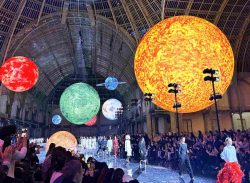
The main venue of Louis Vuitton’s See LV exhibition is seen at Tokyo Midtown Grass Square in Roppongi, Tokyo. The exhibition, which continues through Aug. 21, showcases the past, the present and the future of Louis Vuitton, LVMH’s largest brand.
12:00 JST, August 5, 2022
In the twinkle of an eye, Style Files has become 100 installments old. I started the column way back in March 2014, eight years and five months ago. What has happened in the world of fashion during that time?
In high fashion, Alessandro Michele — creative director of Gucci since January 2015 — was responsible for adding “street” elements to luxury styles. His first collection for the brand was the January 2015 men’s collection, which featured inclusive, slightly left-of-center apparel.
To vie with Gucci, rival fashion firm Louis Vuitton appointed Virgil Abloh as creative director for men’s fashion in March 2018. However, the 2013 founder of high-end street-fashion brand Off-White died in 2021 at 41 from a rare type of cancer. Other notable designers who have passed away in recent years include Karl Lagerfeld in 2019 at age 85, Kenzo Takada in 2020 at 81 and Alber Elbaz in 2021 at 59.
Lagerfeld, who was active until his death, was largely responsible for turning around Chanel, which now boasts annual global sales of ¥1 trillion, on a par with Louis Vuitton and Gucci. Takada was the founder-designer of Kenzo, while Elbaz revived Lanvin after becoming the brand’s artistic director in 2001.
Takada and Elbaz both fell victim to COVID-19, which first became a global threat in February 2020. As of July 18, the disease had affected some 564.1 million people and claimed more than 6.37 million lives, according to the World Health Organization.
The pandemic is the most important global event to have occurred since I started writing this column, but it has had little impact on the world of fashion. However, changes have manifested in other realms, such as the increased popularity of outdoor activities, including camping, golf and running. There has also been a rise in home consumption due the large uptick in remote working.
But fashion-wise, things have been relatively stagnant over the past few years, apart from the “street luxury” movement and face mask fashion.
Since the column began, the biggest winner has likely been multiple luxury brand firm LVMH, whose annual sales more than doubled from €30.64 billion in the business year ending in December 2014 to €64.22 billion in the business year ending in December 2021, marking an annual rise of 44% from the previous year. In the business year ending December 2020, the company’s sales dipped by 17% due to the coronavirus pandemic, but they bounced back to achieve record-level financial results the following year. These results were largely due to price hikes, but it shows that some customers will snap up luxury brand products regardless of high mark-ups.
SPAs (specialty store retailers of private label apparel) have grown alongside luxury brands, but have recently been battling headwinds as sustainability increasingly becomes an issue in the apparel industry. The pandemic has not helped.

Workman has made giant strides over the past eight years and five months. The company has enjoyed great success by selling work clothes that can be worn as casual wear through outlets other than its main stores. Recent hit products include a pair of sneakers priced at ¥980.
In Japan, meanwhile, Workman Co., a manufacturer of work clothing, has made waves by venturing into the casual outfit scene and quickly establishing itself as a major force in the field with price tags for products at about 60% of the prices of Uniqlo outfits. Another new face on the scene is Shein, originally from China, which is growing fast of late. Rise and fall is par for the course in this field. Forever 21, which was extremely popular, pulled out of Japan in 2019 and filed for Chapter 11 bankruptcy in the United States in September that year. The company is now in the process of management reconstruction.
Musing on things during a train journey, I became convinced that the biggest shift in fashion over the past eight years has taken place in the realm of footwear. Looking around my busy train car, one elderly woman was wearing pumps and two elderly men were wearing traditional leather shoes, but everyone else was wearing various types of sneakers. I never expected the sneaker revolution to become so dominant. The change has occurred because commuters have increasingly been adopting casual styles. Fewer men were wearing ties, not just because of the summer heat, but also because the government’s cool-biz campaign to encourage men to wear light clothes in summertime has worked. Styles are becoming increasingly casual, and the sneaker revolution is here to stay.

Akira Miura
Miura is a journalist and a former editor in chief of WWD Japan.
"Culture" POPULAR ARTICLE
-

Van Cleef & Arpels Dazzles with Art Deco Artisanry at Tokyo Exhibit
-

Disney’s ‘Twisted-Wonderland’ Animated Series Puts Villains in Spotlight: New Show Features School Inspired by Classic Disney Films
-

Ayumi Hamasaki’s Shanghai Concert Canceled Day Before Schedule as Part of Beijing Backlash
-

‘The World Masterpiece Theater Series’ Celebrates 50 Years; Animator Looks Back on Creating Anime Classics
-

Popularity of Piggy Banks Across Time and Place Seen at Bank’s Museum of Money Boxes in Hyogo Pref.
JN ACCESS RANKING
-

Tokyo Economic Security Forum to Hold Inaugural Meeting Amid Tense Global Environment
-

Keidanren Chairman Yoshinobu Tsutsui Visits Kashiwazaki-Kariwa Nuclear Power Plant; Inspects New Emergency Safety System
-

Imports of Rare Earths from China Facing Delays, May Be Caused by Deterioration of Japan-China Relations
-

University of Tokyo Professor Discusses Japanese Economic Security in Interview Ahead of Forum
-

Japan Pulls out of Vietnam Nuclear Project, Complicating Hanoi’s Power Plans
























